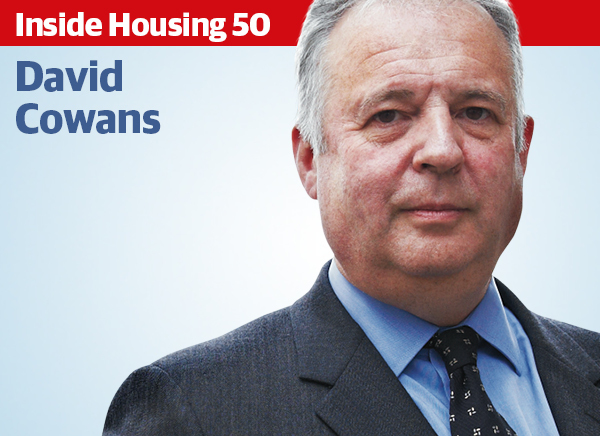You are viewing 1 of your 1 free articles
 Jules Birch
Jules BirchMarking the White Paper out of 10
 Jules Birch
Jules BirchSo have Gavin Barwell and Sajid Javid finally grasped the nettle on the housing crisis?
Critics lined up to call the White Paper a damp squib, a white flag and (my personal favourite) like a wet Tuesday in Bognor.
Some had even read it first.
Supporters called it a pragmatic shift away from policy under David Cameron and “a blueprint for change”.
And there was the inevitable “cautious welcome” from housing organisations.
In some ways, the responses of two of the architects of previous Conservative housing policies were the most interesting ones.
Former housing minister Grant Shapps said previous plans had not made much difference and this one probably wouldn’t either.
Former No10 advisor Alex Morton revealed the cynical political calculation at the heart of previous policy when he warned that “if you get dragged into an argument about renting versus owning, it will quickly become about the need for more council homes”.
The truth is that it depends how you look at the White Paper. Will it solve the housing crisis? Nope.
Does it offer a vision of housing in Theresa May’s “country that works for everyone”? Pull the other one.
Will it do anything for victims of that crisis shown on Tuesday’s Newsnight: the frustrated would-be first-time buyers or the mother stuck in tiny temporary accommodation with her two children for three years in Grant Shapps’ constituency? No, and not any time soon.
But is it an improvement on what went before? Yes, definitely.
And does it qualify as ‘bold’ when judged against the political constraints from No10. Yes, possibly, as Mr Morton’s article shows.
There are several things in it that would have been unimaginable from a Conservative government even a year ago, and several more that represent an important change of tone and emphasis.
My initial verdict concentrated on the affordable housing side of the White Paper.
For a more complete assessment, I thought I’d return to the 10 tests (subsequently expanded to 12) that I set last month.
1. How half-baked is it?
Admittedly the bar was not set particularly high, but most of the ideas are sensible stuff.
Many of them were lifted straight from Labour’s Lyons Review so that’s maybe not so surprising.
Best of all, the White Paper put the bonkers idea of Starter Homes back in its box.
There was no mention of Mr Morton’s crazed and vindictive scheme for forced sales of council houses, even though it was meant to start in April.
I do wish Gavin Barwell would stop saying “there is no magic bullet”, though.
Verdict: 8/10
2. Is tenure neutrality for real?
As I blogged on Tuesday, all the ministerial rhetoric was about “homes to rent as well as to buy” but rent on what terms?
The climbdown on Starter Homes was matched by a clear commitment to a more flexible mix of tenures in the Affordable Homes Programme.
However, the White Paper also added a completely new category to the legal definition of affordable housing: ‘affordable private rent’ or homes let at 80% of market rents by build-to-let investors.
Councils forming local housing companies were warned they will not be able to use them to evade the Right to Buy and the threat of forced sales has not entirely gone away.
Verdict: 3/10
3. What about those who are not managing?
The White Paper will make little difference to Theresa May’s people who are “just about managing” since in her eyes they already have mortgages.
For those struggling to buy, it will make some difference over the longer term. But for those who are really not managing – the young mothers in Welwyn Garden City on Newsnight – it will make no difference at all.
Verdict: 1/10
4. Will it deliver more homes?
It would help if we could agree how many we are building now or before.
In his statement to parliament, Sajid Javid brazenly mixed apples (95,000 starts under Labour) and pears (190,000 net additions in 2015/16) as Tory backbenchers bayed “double”.
This transparent subterfuge was unnecessary and undermined his claim to the moral high ground.
Mr Javid and Mr Barwell did at least have the decency to admit that 190,000 is nowhere near enough though, implicitly conceding the unambitious ambition of their million homes target.
However, the proposals on housebuilding and planning do have the potential to make a difference over the longer term by penalising councils who use dodgy assessments of housing need and encouraging a range of different providers to make a contribution.
Verdict: 4/10 (Mr Javid deducted one point for misuse of statistics)
5. Will it challenge the existing delivery model?
House builders were warned that the government will not tolerate business practices that artificially restrict supply.
There was even a proposal that local authorities should be able to compulsorily purchase sites with slow build-out rates, with the compensation value determined by auction rather than the price they paid.
However, judging from the share prices of the big house builders, the City did not take that threat especially seriously.
Verdict: 4/10
6. What about land?
Anyone hoping for something radical on the green belt will have come away disappointed, even though Tory backbenchers remain suspicious about assurances that development will only be allowed in exceptional circumstances.
However, there were three things on land in the White Paper that are worth a welcome.
First, the government made a commitment to full transparency on the ownership of land and land options.
It will take a while but this is a potentially hugely significant step. Second, there may be more flexibility for local authorities to dispose of their land at less than ‘best consideration’ and additional powers in land assembly.
Third, following on from that, the government will look at the German system of ‘land pooling’ between local authorities and landowners, using land value uplift to finance infrastructure.
Verdict: 7/10 (maybe a bit generous but this was a positive surprise)
7. What about planning?
Ministers do at last seem to have dropped their assumption that planning is red tape that holds back development.
They even accepted that blaming planners for being too slow at the same time as you slash their funding is a bit dumb: councils will be allowed to raise their fees provided they reinvest it in their planning service.
However, the uneasy compromise between national policy and localism continues and the wait goes on for a government brave enough to commission a new generation of towns or major extensions to existing towns and cities.
Verdict: 5/10
8. What about other players?
The White Paper certainly talked the talk on encouraging small builders back into the market and it repeated some previous policies on custom build and community land trusts.
Ministers do seem to get the point about market dominance by a handful of large firms.
Beyond that I’m struggling to see much that will open up the housebuilding market faster than it will consolidate through mergers.
However, strong support in the White Paper for build-to-let will add momentum to the change that is already happening in the wider development industry.
Verdict: 4/10
9. What about prefabrication?
The rhetoric about speed of construction will count for nothing if the market for housebuilding factories is not there. The White Paper did not really address a crucial point made in the Farmer Review: the consistency of demand that factories need will only come from rented housing.
Verdict: 5/10
10. What is the real aim?
One simple assumption ran right through the White Paper and all the ministerial interviews about it.
This is that the only way to solve the housing crisis is to build more homes. Unless you are Ian Mulheirn, this is self-evident, and it’s certainly hard to imagine a solution to, say, homelessness that does not involve more homes.
However, there is also a simple statement at the heart of the crisis: homes cost too much.
Will building 200,000, 250,000 or even 300,000 new homes a year make any difference?
Maybe, but only by building at that scale for decades.
If house prices and rents are determined by supply and demand, new homes are only part of the equation.
The White Paper did have something to say about the overall supply of homes for sale in its proposals to encourage downsizing but it seemed oblivious to the bigger question of supply and demand for credit.
Verdict: 1/10
11. What about renters?
The government will consult on banning letting agent fees. Now it wants longer family-friendly tenancies – but only for the tiny part of the sector owned by build-to-let investors and definitely not for tenants of buy-to-let landlords. These may be small measures in themselves but they would have been unimaginable as recently as 2015.
Verdict: 2/10
12. What about tax?
I was confident that this would not be addressed in the White Paper and I was right. “Fixing the broken housing market” must mean making homes more affordable for people who do not have them. That means addressing the taxation of housing for people who do.
Verdict: 0/10
So has the government finally grasped the nettle? The phrase comes from a piece of country lore.
Touch a nettle softly and its hairs will inject toxins into your skin, seize it firmly in the direction its hairs are growing (I’m told, but have never been brave enough to try it) and it will not sting you.
The White Paper is a small step in the right direction by ministers but the housing crisis will keep coming back to sting them.








